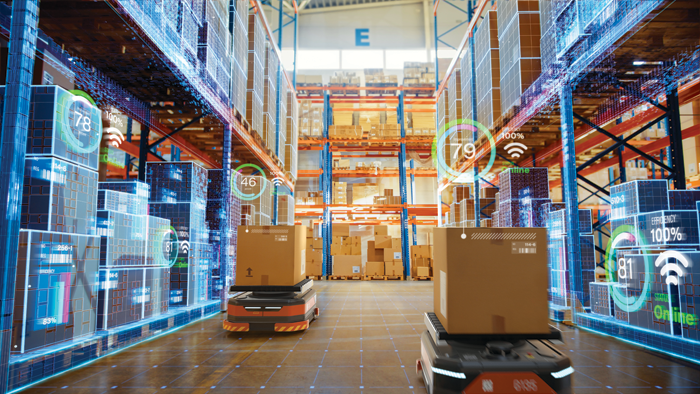The Future Has Arrived

Warehouse automation systems can redefine work flow and results
by Rich Vurva
The high cost of labor and the difficulty in finding employees are driving a growing number of distributors toward considering adopting some form of warehouse automation. Distributors are discovering that advances in technology can generate enough productivity gains to justify the initial investment required to install a warehouse automation system.
The labor crisis
Labor has always been the No. 1 fulfillment challenge, says Fergal Glynn, vice president of marketing for 6 River Systems. He adds that labor availability has consistently reduced year over year.
 “But since the pandemic hit, it’s become a full-out crisis,” Glynn says. “At the same time, buying behavior is changing as more are shopping online more frequently. As a result of both of these changes, distributors are seeing more orders coming in but different order profiles: there are fewer cases and more eaches, so smaller but more frequent shipments are required. This means more labor is required for fulfillment. Most companies aren’t prepared to handle that in terms of labor, or in terms of fulfillment technology. That’s where automation comes in.”
“But since the pandemic hit, it’s become a full-out crisis,” Glynn says. “At the same time, buying behavior is changing as more are shopping online more frequently. As a result of both of these changes, distributors are seeing more orders coming in but different order profiles: there are fewer cases and more eaches, so smaller but more frequent shipments are required. This means more labor is required for fulfillment. Most companies aren’t prepared to handle that in terms of labor, or in terms of fulfillment technology. That’s where automation comes in.”
The return on investment can be calculated differently by each distributor, depending on priorities.
“Cost and time to payback used to be a top consideration for our customers and it’s still important to understand in comparing automation solutions,” he says. “But now, in addition to quantitative calculations such as how we can help increase throughput, decrease cost per pick, or impact time to productivity for associates are more qualitative considerations. For instance, can it adapt to demand changes, in terms of both how and where I need to fulfill; can it scale with my business? Those questions are becoming more common in assessing ROI.”
The good news is, regardless of how you define or prioritize ROI, it’s not a question of blowing up your existing technology. Starting from scratch is incredibly expensive and disruptive. There is technology available that can bolt into existing software to make it easier to do things like manage labor.
Glynn says operations are looking for a solution that they can rely on for a long time. That said, there are certainly operational details to consider when choosing a solution.
First, what do you sell? Not all automation can accommodate all products. What do your order profiles look like? Volume and peaks? Of course, you also need to consider what happens inside your warehouse. How many square feet are you picking across? How many pickers do you have, how many shifts do you run? What other material handling equipment do you use?
In aggregate, that information can help you land on the right automation solution.
Faster service Zac Dieter, vice president of enterprise software and operations excellence (North America) at Savoye, says the need for faster service, smaller order sizes and the labor shortage are three major trends driving businesses to consider warehouse automation solutions.
Zac Dieter, vice president of enterprise software and operations excellence (North America) at Savoye, says the need for faster service, smaller order sizes and the labor shortage are three major trends driving businesses to consider warehouse automation solutions.
He says that consumers expect to get their items much faster than they did before. In addition, because online shopping has become normalized, it’s common for consumers to purchase items as they come to mind instead of waiting to order a larger number of items together. Lastly, whether the lack of talent in the labor market is temporary or not, businesses are realizing that they can benefit a great deal from automating part of their operations.
“A distributor can determine their return on investment by looking at three things. First, examine how much money is saved on labor. Second, consider if there is a positive change in the number of customers abandoning their shopping carts due to delivery timeline. Third, take note of the reduction in picking errors,” Deiter says.
He adds that distributors should first determine the SKU set that best fits the automation. Don’t try to force all SKUs into automation. Distributors should also consider on-hand inventory levels and get a system that makes sense for your operation.
“An over-designed system can increase system cost and lengthen return on investment. Lastly, consider your five-year growth estimations for order volume and SKU count,” Dieter says.
According to Dieter, an automated warehouse solution can increase order accuracy, make it easier to process expedited orders, reduce picking labor and headcount, reduce floor space by replacing standard storage fixtures, optimize the use of vertical height within a building and increase accuracy of inventory levels.
Labor shortage drives change
Dan Labell, president of Westfalia, agrees that the labor shortage is driving automation in today’s warehouses. “As most of labor is used at the single layer and case pick level, we see more distributors turning to automation to keep up with the demand in order fulfillment. Automated Storage/Retrieval Systems (AS/RS) automate up to 90 percent of that manual labor to not only mitigate the strain on low labor but give your workforce time to focus on quality control within your facility.”
 In addition, higher demand and SKU proliferation means facilities need to be larger and more robust, handling complex orders at higher rates. Expanding a facility’s footprint isn’t always in the budget, or warehouses located in urban areas may be landlocked. AS/RS can double the storage capacity compared to a conventional warehouse, so companies will see a greater flexibility and cost justification for implementing automated systems.
In addition, higher demand and SKU proliferation means facilities need to be larger and more robust, handling complex orders at higher rates. Expanding a facility’s footprint isn’t always in the budget, or warehouses located in urban areas may be landlocked. AS/RS can double the storage capacity compared to a conventional warehouse, so companies will see a greater flexibility and cost justification for implementing automated systems.
Labell suggests that distributors should take a few key steps when making economic justifications of an AS/RS. “Put a plan in place and build a comparison model, making sure the model is scalable as you inevitably grow. Then, define the operating cost for both conventional and automated systems, comparing both with projections for the next decade. Typically, an AS/RS has a lifespan of well over 15 to 20 years. And finally, you take your projected long-term cash flow and bring them back to the present. If done right, you can virtually guarantee the solution will drive company growth and profitability well into the future,” he says.
Space constraints and inventory volume, especially as it relates to shipping units, should be one of the first considerations when deciding to implement automation. Labor restrictions and construction costs should also be taken into account.
In addition, risk mitigation should be top of mind no matter the system design. He says to start by identifying industry and company challenges that need to be solved, then identifying the best system for those pain points. All of this can be done through a data analysis (through inventory, equipment and process data collection) to ensure the solution is flexible and reliable enough to fit your long-term needs.
“Automation is the future of distribution and warehousing,” Labell says. It creates a faster, more reliable and more accurate order fulfillment process, consolidating FIFOs and optimizing workflows. Replenishment and order staging can also be conducted during non-peak hours, which not only benefits warehouses during times of labor shortages but can ensure trucks can be turned faster at the dock and orders can stay on schedule. Space optimization is also a huge benefit. AS/RS can store pallets two to 12 deep and be as high as 140 feet.
“While being able to fit 40 percent more inventory, the smaller footprint also saves on upwards of 50 percent on energy costs. Ultimately, automating distribution can mean greater efficiency, accuracy, flexibility and safety of a facility, improving the customer experience while benefiting your bottom line,” he concludes.
Labor shortage worsens
The labor challenges for warehouse applications started before the pandemic, as turnover rates were 30 percent to 35 percent annually. According to Brian Markison, senior director of AGV sales for Mitsubishi Logisnext Americas, the labor shortage has gotten worse as the pandemic increased e-commerce business, creating even more demand for higher and 24/7 throughput for most warehouses. To make this a perfect storm, the low unemployment rates and the “Great Resignation” has made hiring new staff even more challenging.
 Safety is another key area of focus. The U.S. Bureau of Labor Statistics reports 4.8 injuries per 100 full-time warehouse workers annually. This high incident rate is over 50 percent higher than the overall average for the workplace. On a more serious note, 1 out of 765 companies in the warehouse and storage segment will have a fatality at the company, annually.
Safety is another key area of focus. The U.S. Bureau of Labor Statistics reports 4.8 injuries per 100 full-time warehouse workers annually. This high incident rate is over 50 percent higher than the overall average for the workplace. On a more serious note, 1 out of 765 companies in the warehouse and storage segment will have a fatality at the company, annually.
The ability to have 100 percent traceability and accuracy for items moved and stored within the warehouse is another key trend. The AGV system does not misplace a pallet or grab the wrong pallet, plus the AGV control system maintains a history of all the moves and can update a company’s WMS/WCS/ERP.
Another notable trend is companies looking to reduce vehicle, product and building damage. “With the AGV’s safety scanners and navigation system, the AGV will operate safely within the facility and will nearly eliminate any damage,” Markison says.
Understanding the benefits from implementing an automation solution is the key to overcoming the challenge of calculating a return on investment. The following are several categories to consider:
- Reduce the costs of continually recruiting new employees
- Reduction in retraining costs for new hires
- Reduction of overtime as AGVs fill the gap
- The value of utilizing the staff for higher value activities
- Cost reduction in warehouse accidents
- Cost reduction of damage to vehicles, products, and the building
Key considerations should be understanding the processes that are used within the facility; key metrics on pallet movement with peak volumes; performance level requirements to meet other processes; and current CAD layout of the warehouse area. Automation solutions have a significantly better chance for success if the process that is to be automated is well documented. Plus, it allows the solution provider to review the processes and select the best path forward on a journey through different phases of automation to be implemented.
Key data on the performance within the warehouse such as the number of movements per hour with top end peak volume identified will allow the automation solution provider to scope the size of the system appropriately to meet the requirements upstream and downstream from this process.
“We had a customer that was able to add an additional shift and not increase headcount, but still increased their output from that warehouse by almost 30 percent,” Markison says. “Another customer that implemented our AGV solution was able to reduce their product damage by 90 percent.”
Markison says another customer lowered the temperature where AGVs operate and turned off lights compared to areas where humans work, providing annual energy cost savings.
“Our AGVs can work in a completely dark warehouse,” he says.
This article originally appeared in the March/April 2022 issue of Industrial Supply magazine. Copyright 2022, Direct Business Media.











